
6 Incredibly Simple Steps to Start a Print on Demand Business
Admit it: we all can now earn money from anywhere and create thriving online businesses. The evolution of digital technology has brought many unprecedented business opportunities, and print on demand is one of them.
Whether you are a designer, an artist or even just a normal person, provided you have some creative juices flowing and want to make a living from them, you can start your own print on demand business right now. Forget about creating products, shipping the items, or doing any of these time-consuming tasks. All you have to do is to design your stuff, have it printed on demand, sell it, and you can earn a passive income day in, day out.
Interested? If so, let’s dive into this 6-step process to learn how to start a print on demand business today.
Note: The words “print on demand platforms” and “print on demand sites” are used interchangeably. For the sake of this blog, they have the same meaning.
Step 1: Choose the right platform
When running a print on demand business, the first and very important step is choosing a platform. Think about this: whenever a buyer places an order, that platform will print, manufacture, and ship the order individually for the buyer. They control the whole process of production and delivery, so your success heavily depends on them.
There are so many print on demand sites to choose from, so you should do a bunch of research to pick the right one. Here are some of the best platforms that you can consider:
#1 PrintBase
PrintBase is by far the most popular print on demand platform with a huge collection of products. They ensure the highest product quality, and the printing quality is also much better than many of their competitors.

Generally, PrintBase works similar to other print on demand sites out there, but it’s merely a print on demand platform of its own.
Pricing: PrintBase has a clear pricing policy. The platform only charges for the base price of each item, and anything extra that you get goes straight to your wallet. For example, if an item costs $5 (base price), and you sell it for $15, then you make $10 in profits.
Delivery: PrintBase doesn’t offer free shipping, but they give you a good shipping service which makes it worth the money.
#2 Teespring
Teespring allows you to create custom products to sell on their platform. Like Redbubble, Teespring also takes charge of printing, fulfillment, delivery, and customer service.
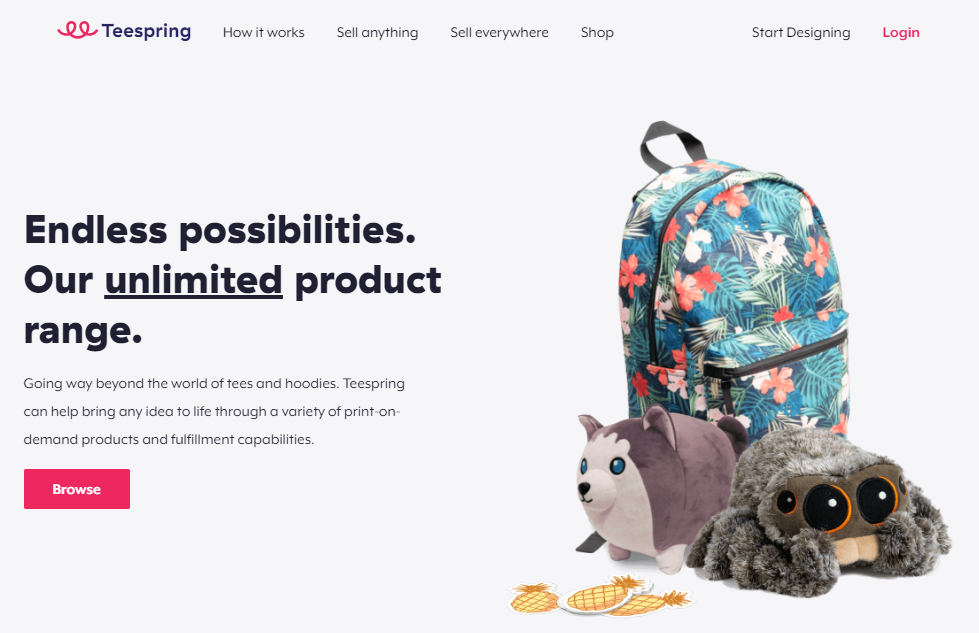
On Teespring, you don’t need to set a sales target. When an item is sold, the order will be fulfilled and shipped, meaning you get the money. Regarding printing, each product has a different printable area where you can put your design. These printable areas have a limit, so if you cross this limit, your entire design won’t be printed.
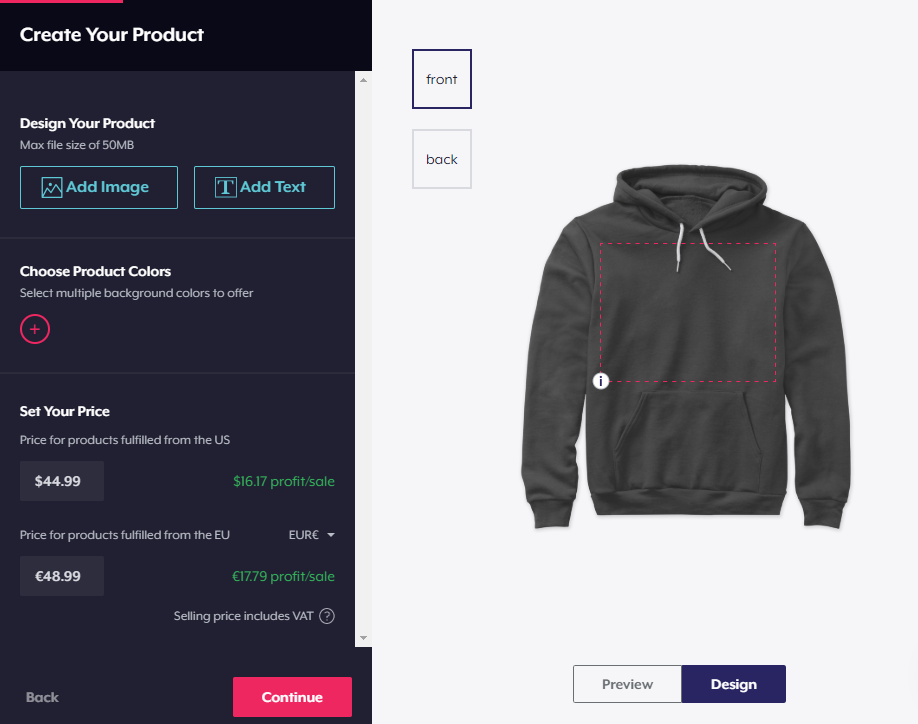
Pricing: Teespring charges you a fixed price per item as Redbubble does. You choose the selling price and keep 100% of the profits after deducting the base price.
Delivery: Teespring has three different shipping fees, depending on whether your customers are based on the United States, Canada, or outside these countries. Rush shipping is also available on some products with an extra fee.
#3 TeeChip
TeeChip has many of the same features as other popular print on demand platforms do, but it offers some unique ones as well. The first thing, also their unique selling proposition, is custom-domain offering. It allows you to create your own store on TeeChip and customize it with your own domain name. Here is a typical example of a store with a custom domain created with TeeChip.
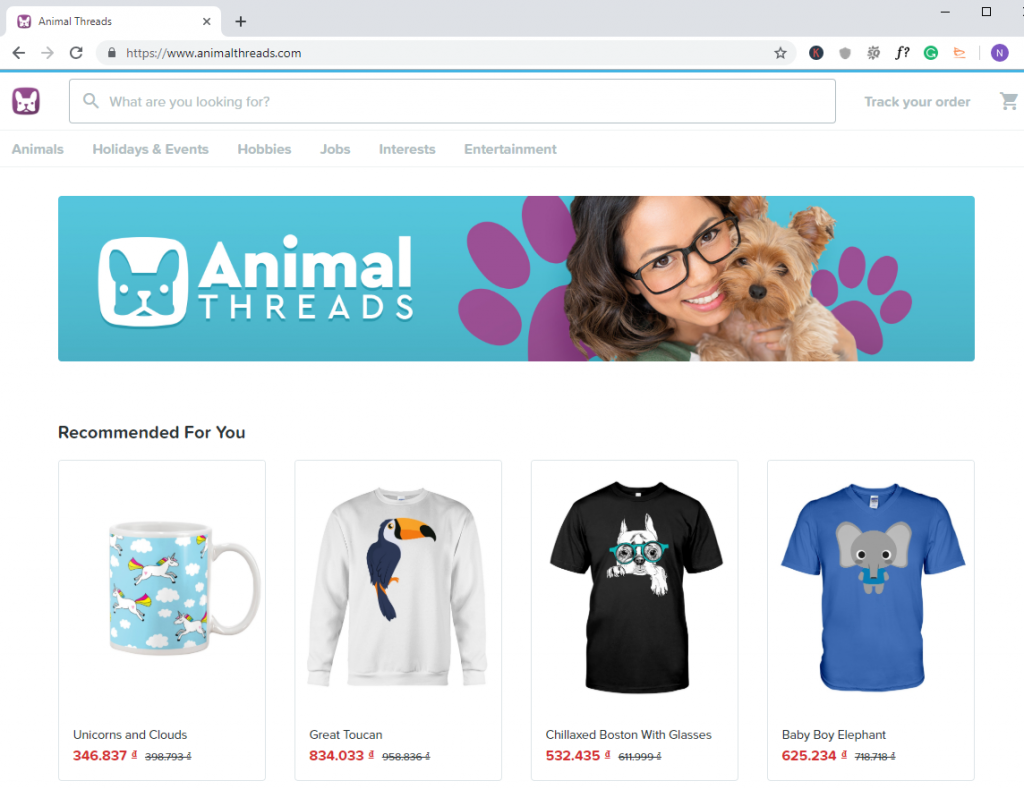
Pricing: TeeChip has a base price and a retailer price minimum for each product. You can go to the official product pricing page to see how much you have to pay and how much you can earn on each item.
Delivery: TeeChip offers different shipping costs, based on the destination and the number of products in each order. Normally, the platform charges $3.99 per item along with $1.99 per extra item for delivery.
#4 Merch by Amazon
Started by Amazon in 2015, Merch by Amazon is a fairly new print on demand platform, compared with others in this list. This site mainly focuses on t-shirts and possibly limits for those who want to sell mugs, beach towels, etc. It is available by invitation only.
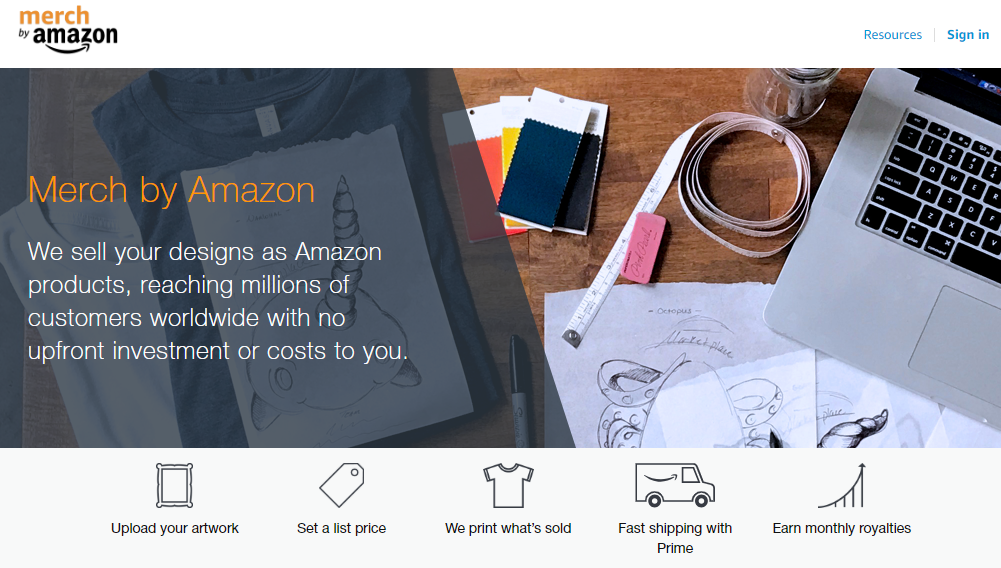
Pricing: Merch by Amazon offers you a royalty for each of your product sold. This royalty is based on the list price that you set excludes Amazon’s costs for raw materials, printing, fulfillment, customer service, and shipping. Go to the Royalties page to learn more about this.
Delivery: Merch by Amazon products have the same shipping options as other items sold by Amazon. If a customer spends more than $25, they get free shipping. All other customers are given the option to buy ground shipping or pay more for faster delivery.
#5 GearLaunch
GearLaunch is ideal for eCommerce owners who already have a Shopify store. This POD platforms also provides full-service storefront which you’re able to sell under your own domain.
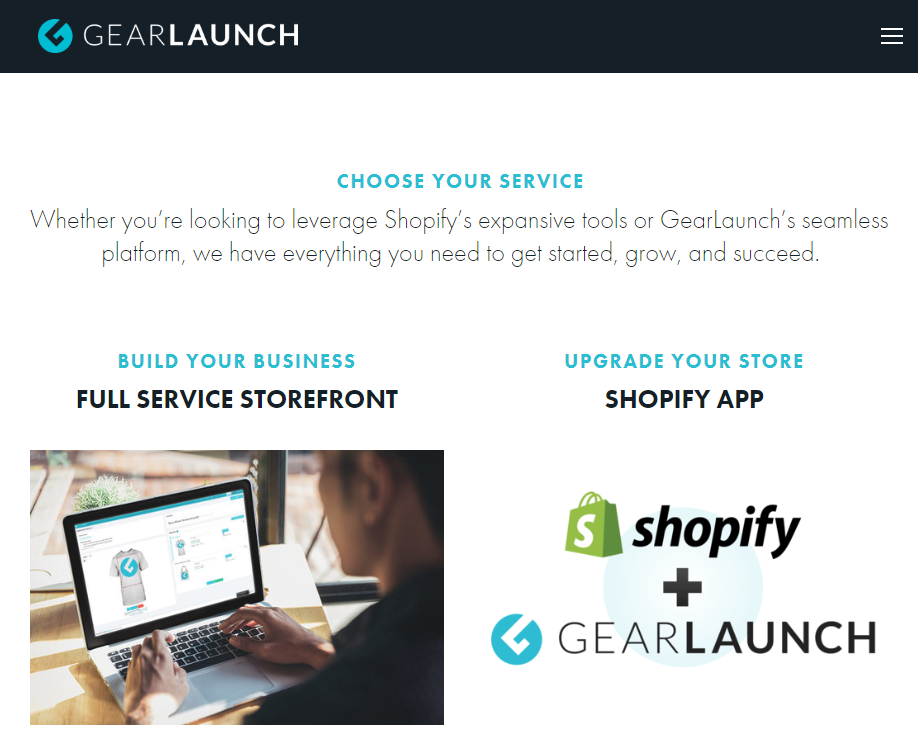
Pricing: GearLaunch uses a tiered pricing structure to make sure you get the most money as possible. You can use this product catalog to figure out their current product offerings and discounted pricing per tier.
Delivery: Shipping fees vary depending on the size, weight, and number of items in an order. Standard shipping times for domestic orders is between 5-10 working days. For international orders, shipping can take 2-4 weeks.
Tip:
To pick the right print on demand platform, take enough time to answer these questions:
- Does the platform have large audiences? Do you want to leverage its audiences? Or, do you have your own audiences and want to create your own store?
- Does the platform have a wide range of products to sell? Some people may only focus on t-shirts, but others want to print on demand a lot of products.
- Does the platform offer low base price (means high margins)? Earning a good margin on your products benefits your bottom line.
- Does the platform offer a good design app? This may not be important if you use professional design tools like Adobe Illustrator. But some people often use the online design app provided by the platform. If you go with the latter, make sure the app is fully functional.
Now, you’ve known the most widely-used print on demand platforms. Let’s say your choice is Teespring. The following parts of this article will show you how to run a print on demand business on this site.
Step 2: Decide how you want to sell your design
There are two common ways to sell your print on demand products. You can choose to sell on your platform’s marketplace or on your own store.
#1 Sell on your chosen platform’s marketplace
With this method, you just need to create an account, upload your design, and start selling. Recall that you assumingly choose Teespring to sell your design. The platform has already done all the marketing legwork, so you can make use of free traffic to grow sales. Besides, selling your products through Teespring makes it easy to manage your entire collection.
However, this selling method comes with the downside of no branding at all. You don’t get the benefits of naming your brand and branding your own store. In addition, you would be one of hundreds of thousands of other artists selling their work on that platform. The competition is very high, and your potential customers can wander around your store, but then go to another to buy. Obviously, it isn’t always a bad thing, but if you’re looking to sell the stuff on your store under your own branding, this method isn’t the right choice.
#2 Sell on your own site
You have to create your store site on Shopify, WooCommerce, BigCommerce, ShopBase, etc. Then, upload your designs to your store and connect with a print on demand platform. Also, you’re responsible for marketing your products. Once you have an order, your chosen platform will print the design and deliver the product to your customers.
So, how can you know which method is better to sell your design? Generally, it depends on your business strategy and budget. If you have a large investment and don’t want to compete against others, building your own print on demand store may suit you. But, if you know a platform has a large audience and want to make use of it, you should list your design on this platform.
We continue to assume you want to sell directly on Teespring. Move on to find out what the next steps are.
Step 3: Find your print on demand products
Most people know they can make a career with print on demand. But many of them are struggling with finding their niches. “What should I sell at TeeSpring?” seems to be a common question.
Print on demand is a big label for an (almost) endless list of different products. We’re all familiar with t-shirts, mugs, towels, and phone cases, but increasingly there are new products available to print on demand. On Teespring, you can design a lot of products, like basic tees, tank tops, v-neck shirts, stickers, pillows, etc. Everything else from mouse pads, magnets to underclothes and bodysuits can be a good niche, as well.
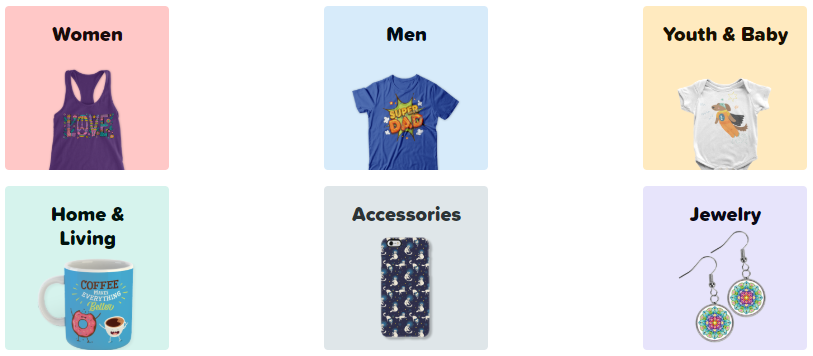
Source: TeeChip
To find your print on demand products, you can use many tools like Google Trends, Google Search, or SortingSocial. Regarding SortingSocial, this is very powerful to sort out products that people actually want to buy. You just need to log in, choose which platform you want to search on (like Pinterest, Facebook, Etsy, or Wish), and then enter a keyword. After that, you’ll get results which help you come up with unlimited ideas for your business, based on things that are trending.
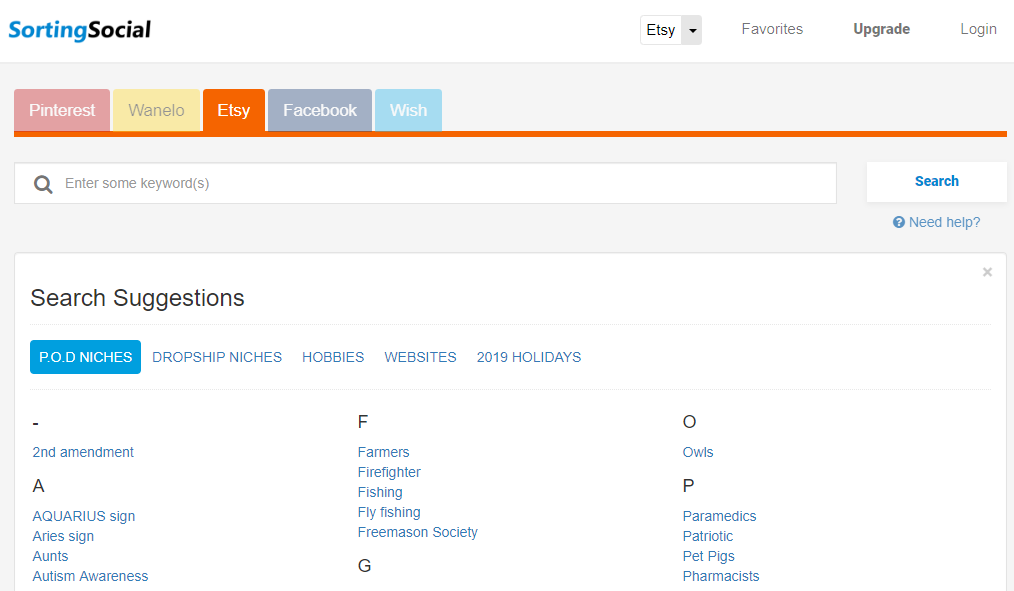
Tip: If you’re still stuck with finding a niche, read this to find out top 20 print on demand products to sell for 2019.
Step 4: Get your design ready
For creatives like artists and illustrators, their design is probably ready good to go. In case you don’t currently have any design, and you’re looking for inspiration to create some yourself, you can try these ways to find ideas:
- Go to other stores on TeeSpring and learn from their ideas. Never copy their ideas exactly but you can edit them to make your own. For example, the Pencilmation store has many awesome designs that can inspire you a lot.
- Look back on some of TeeSpring Success Stories to see how top creators developed their design concept.
- Read the hottest all-over print design trends to try with TeeSpring.
- Check out Pinterest, Zazzle, Amazon, Etsy, etc. for popular designs and niche themes.
- Google Search your design “message” to see if there are existing or similar designs you can get inspiration from.
- Reach out to your community or target audience for suggestions on what they’d like to see.
Once you find some ideas, you can use Canva, Place-It T-shirt Designer, Typorama, or Pablo by Buffer to create quality designs for your products. Remember to choose different size of images for your designs for different sized products. A design that looks good on a tank top may not be as good looking as on a bag.
Note:
- You should read TeeSpring’s design support guide to know how successful ideas look like.
- To ensure the highest quality print, stick to their design file notes.
- When creating a design, pay much attention to trademark and copyright laws. At the same time, ensure your design idea obeys Teespring’s intellectual property policies.
Step 5: Create your products
This step is about creating a listing and setting up a storefront on Teespring.
#1 Make a listing
To sell your design on Teespring, you need to create a listing. Basically, a listing shows detailed information about your product, and it’s key to convert visitors into customers. It’s easy and quick to do using Teespring Launcher.
When creating your listing, remember to optimize it to sell through Teespring Marketing and Boosted Network. Do the following:
Title
- Create a descriptive listing title because it’s a crucial element to optimize your listing. For example, “Proud Soccer Mom T-Shirt For Mother’s Day” is a good title. It has keywords related to the design: proud, soccer mom, t-shirt, mother’s day. These words are not only relevant to the design, but they’re also words a visitor might search for.
- Don’t repeat keywords and include words describing the product type, color, size, etc. They’re already automatically incorporated into listings. At the same time, avoid using words like “limited edition”, “over 5,000 sold”, or “ending soon”.
- The title length should be between 5 and 8 words (40 character limit).
URL
- Customize your listing URLs with relevant keywords. If your design is “soccer mom”, and your product is a shirt, add the word “tshirt” to the URL, for example, teespring.com/soccer-mom-tshirt.
Description
- Include content that is relevant to your design. Use phrases that could help a visitor self-identity with your design theme.
- Avoid random keywords and stuffing keywords.
#2 Create a storefront
A storefront is where to showcase your collections of beautiful designs on Teespring. By creating a storefront, you will possibly drive sales and build a true brand which keeps your customers come back again and again. Teespring reported that grouping listings into a storefront helps get 58% more views and sell 19% more items.
You can read Teespring’s tutorials to set up a storefront. But before doing this, make sure you have at least two live listings.
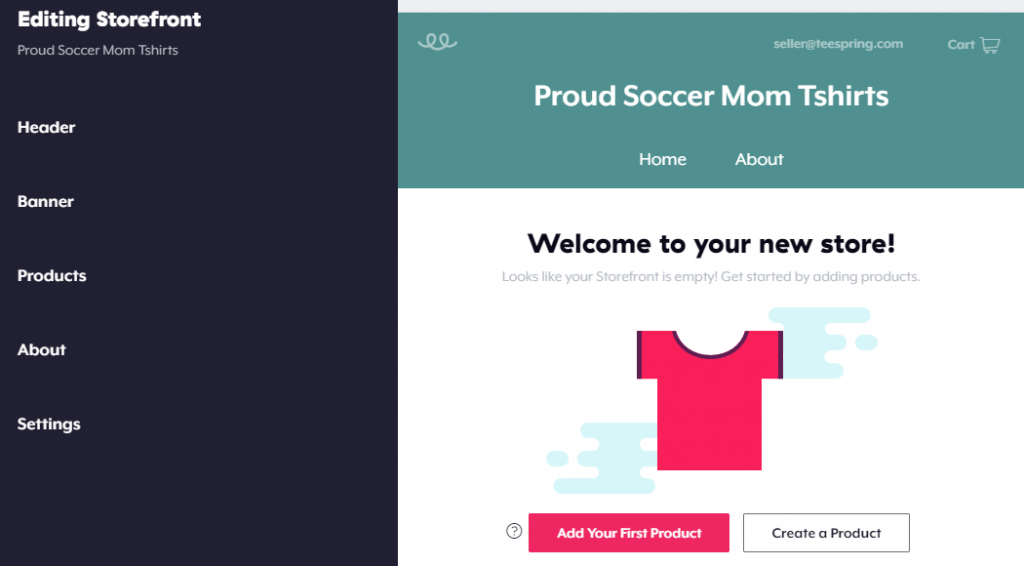
Remember this:
- Add a wide variety of products, at least two or more designs. But, limit the number to 200 products or less for optimized site speed and load times.
- Group related designs within a store to increase the chance of making additional sales.
Step 6: How to promote your products
Bravo! You’ve already created your products to sell on Teespring. It’s time to share them with the world. Try these three best practices to advertise your products and get the first orders:
#1 Cross-sell products on your storefront
There’s the Cross-Sells option when you create a storefront. This is a useful feature for increasing your buyers’ cart size at checkout – resulting in higher average order value.
When you enable Cross-Sells, Teespring will show your other products at product pages (also called campaign pages), checkout pages, and the thank you pages after purchase. See the example below:
#2 Use Instagram to boost sales
Many Teespring sellers use Instagram to advertise their work and get very good results. Some claim that most of their sales come from organic Instagram traffic.
To grow sales with Instagram, try the following ad-free tips:
- Create one Instagram account per storefront/niche. If you have many storefronts, create a separate Instagram account for each of them. Then, add your store link to the “bio” section on Instagram, as the @quarrot account did.
- Use all of your hashtags, but avoid use generic hashtags like #shirt. The more specific the better.
#3 Host contests
You can give away some incentives to get your followers to share your products. For example, the Teespring seller Jahova offered signed shirts and custom video game equipment to his audience on YouTube. The game rules are simple, that is, his followers had to submit a picture of themselves in a shirt bought on his tore. By the time the game ended, he sold over 2,000 shirts.
Also, you can run Facebook ads and other advertisement methods to boost your conversion rate. We recommend you should read the Driving Sales guide of Teespring, which is really helpful.
Read more about this topic at 15 Highly Effective Ways to Promote a Product
Take action!
It’s possible to make money from a print on demand business, and it’s easy to get started. The key to success is understanding what you should do first and what’s next. We do hope this detailed guide will help you formulate a successful plan and scale your business right away.